Key takeaways:
- Multisensory teaching techniques engage various senses, enhancing learning and emotional connections to the material.
- Incorporating music into lessons fosters creativity, improves memory retention, and creates a vibrant learning environment.
- Practical strategies, such as hands-on activities and movement, deepen student understanding and engagement in music education.
- Challenges in implementation include managing diverse sensory experiences and logistical planning, underscoring the need for flexibility and thoughtful execution.
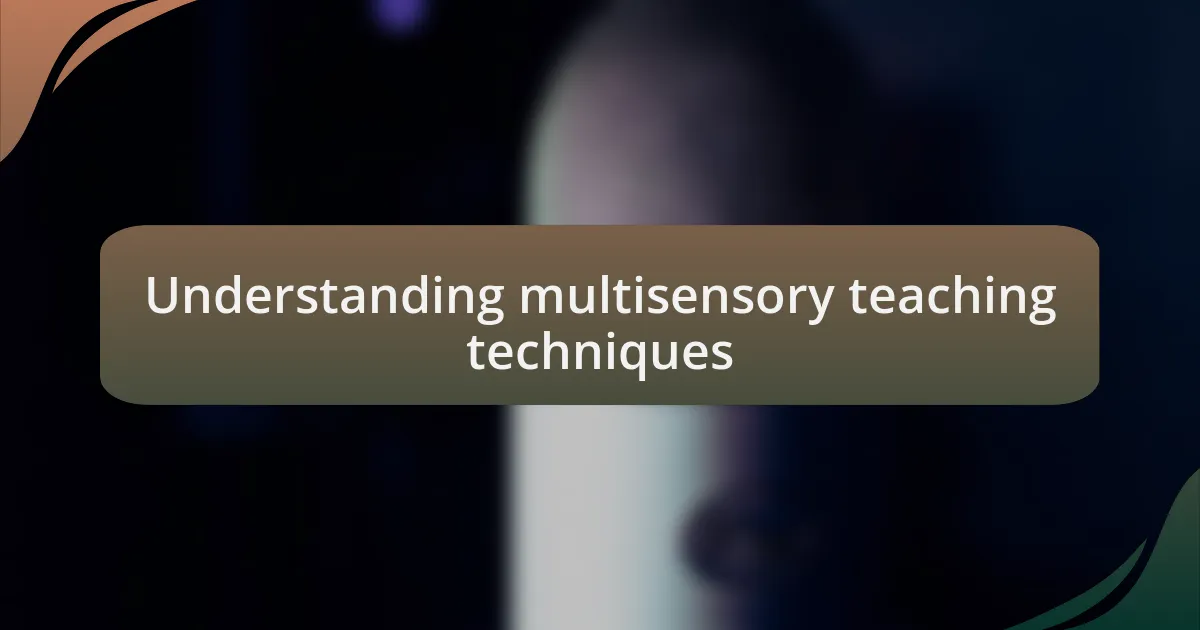
Understanding multisensory teaching techniques
Multisensory teaching techniques engage multiple senses—sight, sound, touch, taste, and movement—to create a richer learning experience. I remember the first time I employed this approach in my music classroom. I had my students not only listen to a melody but also play it on instruments while moving their bodies to the rhythm. It was fascinating to watch how this combination captivated their attention and deepened their understanding.
When we consider how different learners absorb information, it’s clear that not everyone thrives with traditional teaching methods. Have you ever found yourself struggling to learn a concept that just didn’t click? By incorporating visual aids, kinesthetic activities, and auditory components, I have seen students who once felt lost suddenly blossom. The joy in their eyes when they grasp a challenging concept is truly rewarding.
Furthermore, multisensory techniques can establish emotional connections to the material. For instance, when I introduced classical pieces by inviting students to paint or draw while listening, their interpretations were both personal and insightful. This interaction not only solidified their comprehension of the music but also elicited emotional responses, creating a memorable learning experience that went beyond mere notes and rhythms. Isn’t it incredible how engaging more senses can lead to deeper emotional engagement?
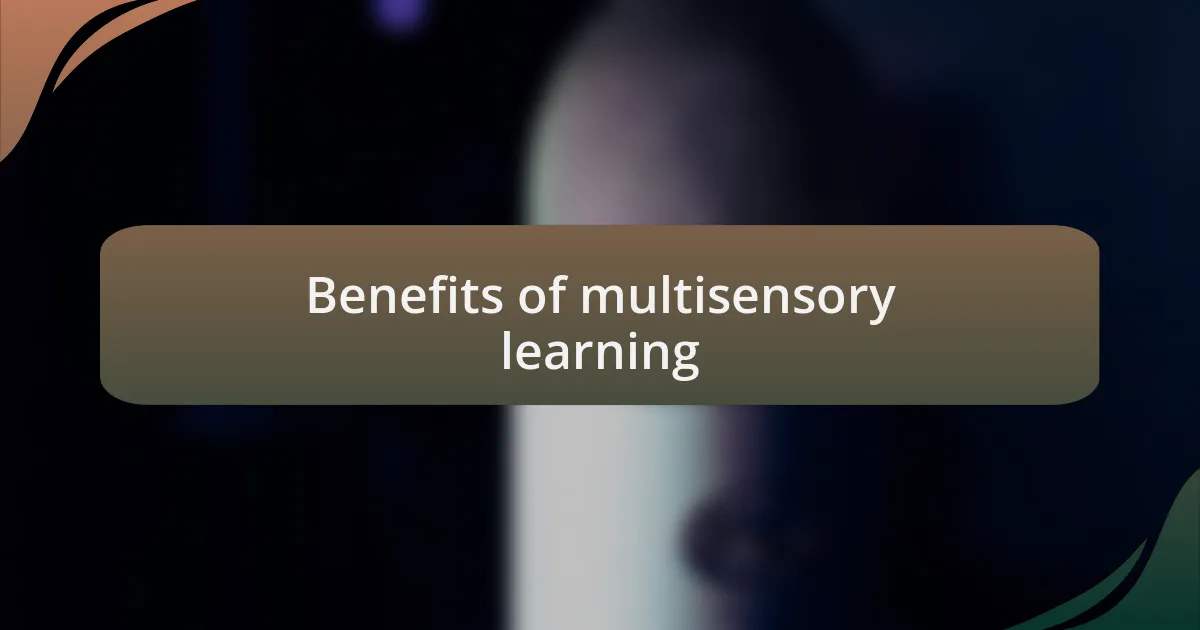
Benefits of multisensory learning
The beauty of multisensory learning lies in its ability to cater to diverse learning styles. I fondly recall a particular lesson where students were learning about rhythm. By incorporating clapping patterns while playing drums and juggling scarves, I noticed those who struggled with auditory processing suddenly found their groove. It reminded me that when we allow students to connect the dots through various channels, learning becomes both an adventure and a celebration.
Additionally, multisensory techniques foster creativity and innovation. One day, I asked my students to compose their own short pieces of music while manipulating colorful visual aids that represented different musical elements. The energy in the room was electric! Watching them blend sound with color sparked a level of creativity that I hadn’t witnessed before. This blend not only resulted in unique compositions but also instilled confidence in them as budding artists. Isn’t it amazing how engaging other senses can unlock hidden talents?
Moreover, multisensory approaches can lead to better memory retention. I’ve found that when students physically participate in their learning—like stepping on different colored mats to signify various notes—they’re more likely to remember the music concepts long after the lesson ends. There’s something powerful about connecting physical movements with cognitive learning. It truly shows me that the more we engage the senses, the more memorable and impactful the learning experience becomes for everyone involved.
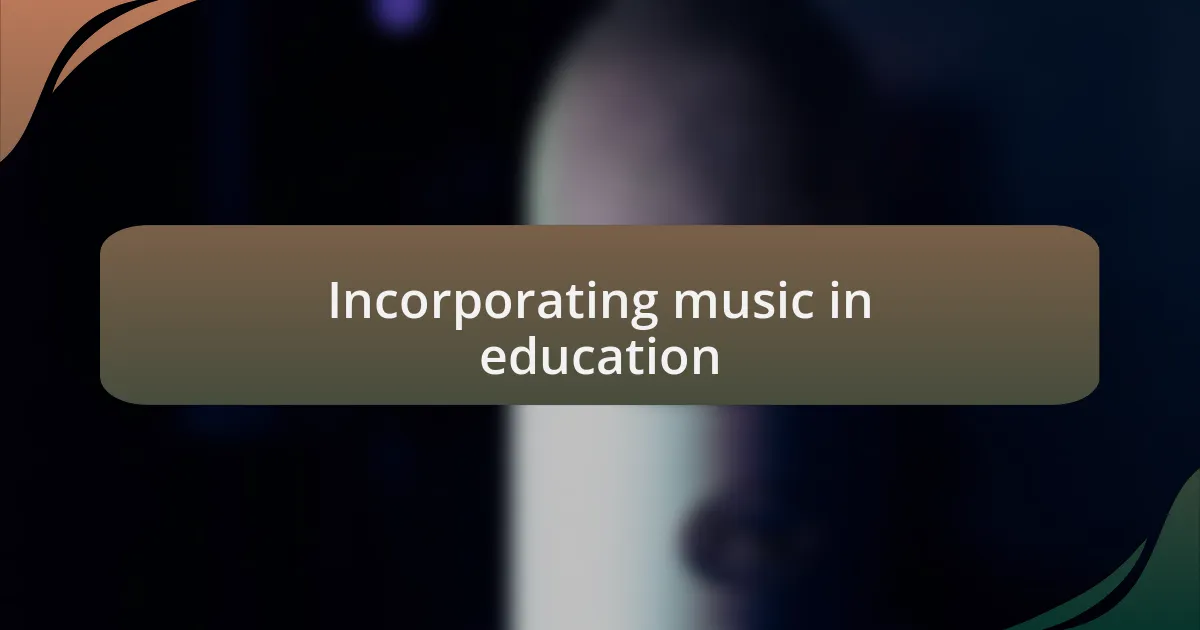
Incorporating music in education
Incorporating music into education has a transformative effect on students’ engagement and understanding. I remember a project where we used songs to teach historical events. Students would create raps about significant figures, and the excitement in their voices was palpable. This experience made me realize that when we infuse history with melody, it not only becomes more memorable but also fosters a deeper connection to the material.
I’ve also noticed that using music as a backdrop during quiet work sessions elevates the atmosphere in the classroom. One day, I played soft instrumental music while students worked on their assignments, and the focus in the room shifted dramatically. It was like magic—suddenly, distractions faded, and creativity flourished. Isn’t it fascinating how a simple tune can cultivate an environment ripe for learning?
When we explore the world of music in education, we often uncover layers of creativity that might otherwise remain hidden. I vividly recall encouraging students to invent their own soundtracks for stories they had written. The joy on their faces as they paired their narratives with melodies revealed just how powerful music can be as a storytelling tool. It made me reflect on the idea that music is not merely an art form; it’s a vessel for imagination and communication.

Practical strategies for music teaching
Music teaching can greatly benefit from incorporating hands-on activities that engage multiple senses. I remember an instance when I had my students craft their own instruments out of everyday objects. The laughter and excitement as they fumbled with cups, rubber bands, and boxes brought about a unique energy. Suddenly, they weren’t just learning about sound; they were experiencing creativity in action. Isn’t it amazing how making something can ignite a deeper appreciation and understanding of music?
Another effective strategy I’ve found is integrating movement with music lessons. When I introduced a lesson on rhythm through dance, students became fully immersed in the concept. They clapped, stomped, and swayed to the beat, which made the lesson feel alive. It was like watching a light bulb go off over their heads as they realized rhythm isn’t just a musical term—it’s a part of who we are. Have you ever seen how physical activity can amplify a child’s understanding? It’s genuinely inspiring.
Utilizing technology in music education has also opened new doors for my teaching. I vividly recall a project where students used music software to compose their own pieces. The pride in their eyes as they shared these creations was unforgettable. It’s fascinating how digital tools can empower students, transforming them from passive listeners to active creators. Wouldn’t you agree that this shift can foster a lifelong passion for music?
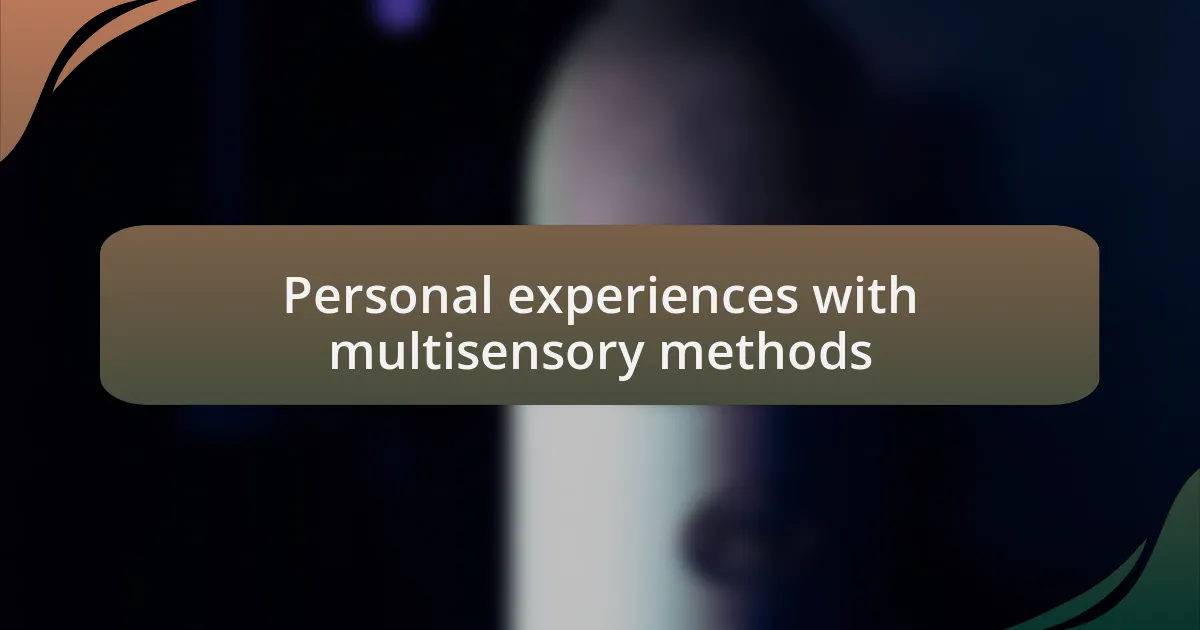
Personal experiences with multisensory methods
I’ve always believed in the power of engaging multiple senses, and that became crystal clear during a group project on musical storytelling. Each student brought an object from home that represented a sound or emotion related to a song we were studying. The room was filled with diverse sounds, from the gentle chime of a windbell to the exciting crash of a tambourine. Watching them weave those objects into their musical narratives not only enhanced their understanding but also created a magical atmosphere of collaboration and creativity.
One memorable experience involved a music lesson where I combined visual art with sound exploration. I invited my students to create a visual representation of a piece of music they had just heard. As they painted, I played different pieces, and the colors and strokes they chose mirrored the emotions of the music. The transformation of mere sound into vivid art was a moment of realization for them—music is not just audible, but it also paints pictures in our minds. Have you ever observed how art can translate emotions that words sometimes fail to capture?
A particularly impactful method I’ve employed is integrating storytelling with music. I remember introducing a lesson where we related a musical piece to a classic story. As we discussed the emotions and scenes, I encouraged my students to express their interpretations through movement. Their stories unfolded physically in a way that made the music resonate on a deeper level. It left me thinking: how often do we miss these connections in traditional teaching? Seeing students engage fully in their learning journey through such multisensory experiences truly reinforced my belief in this approach.
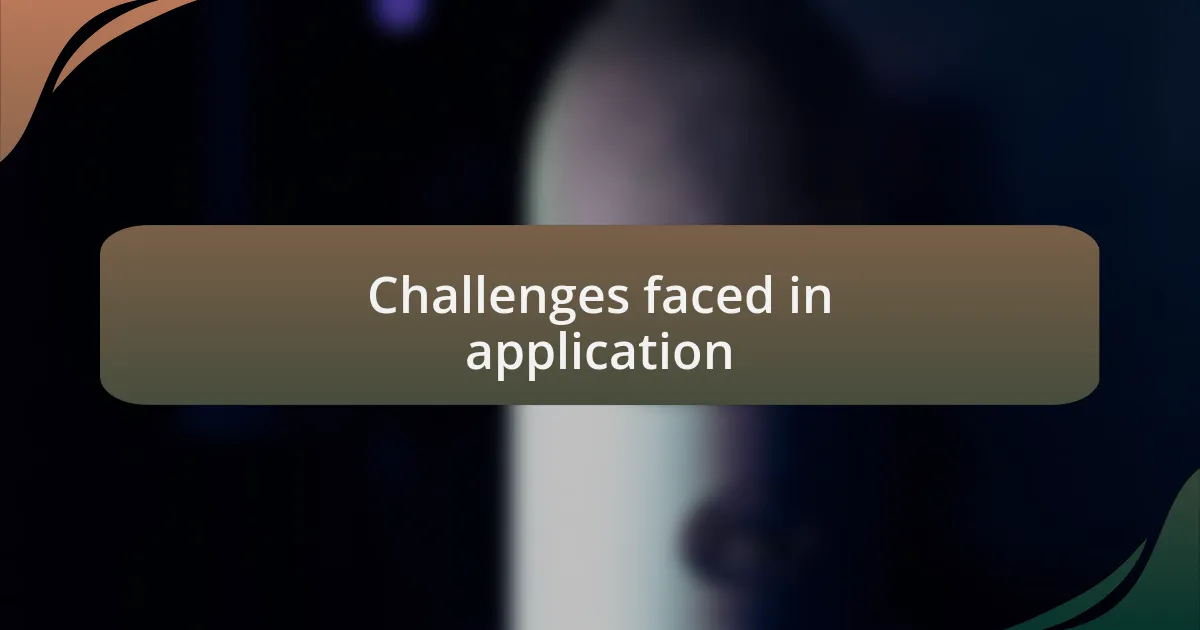
Challenges faced in application
Implementing multisensory teaching techniques isn’t always smooth sailing. I recall one session where my classroom buzzed with excitement as we attempted to blend music with cooking smells, hoping to spark creativity. However, the integration of scents—though exciting in theory—resulted in overwhelming chaos. It turned out that not all students enjoyed the same aromas, leading to distractions rather than inspiration. Have you ever faced a situation where your well-laid plans didn’t pan out as expected?
Another challenge I encountered was the varied levels of sensory interpretation among my students. During a unit focused on rhythm and movement, I noticed that some students thrived while others struggled to connect. I genuinely felt for those who couldn’t quite grasp the concept; it made me rethink my approach. How do you ensure that every student feels included in a sensory-rich environment?
Lastly, the logistics of integrating multiple sensory activities can be quite demanding. I remember planning an ambitious project that involved music, art, and even some physical movement, but organizing materials and time left me stretched thin. It made me reflect: is the effort worth the outcome? Balancing the ambition of multisensory teaching with practical execution often requires more thoughtful planning than one might expect.
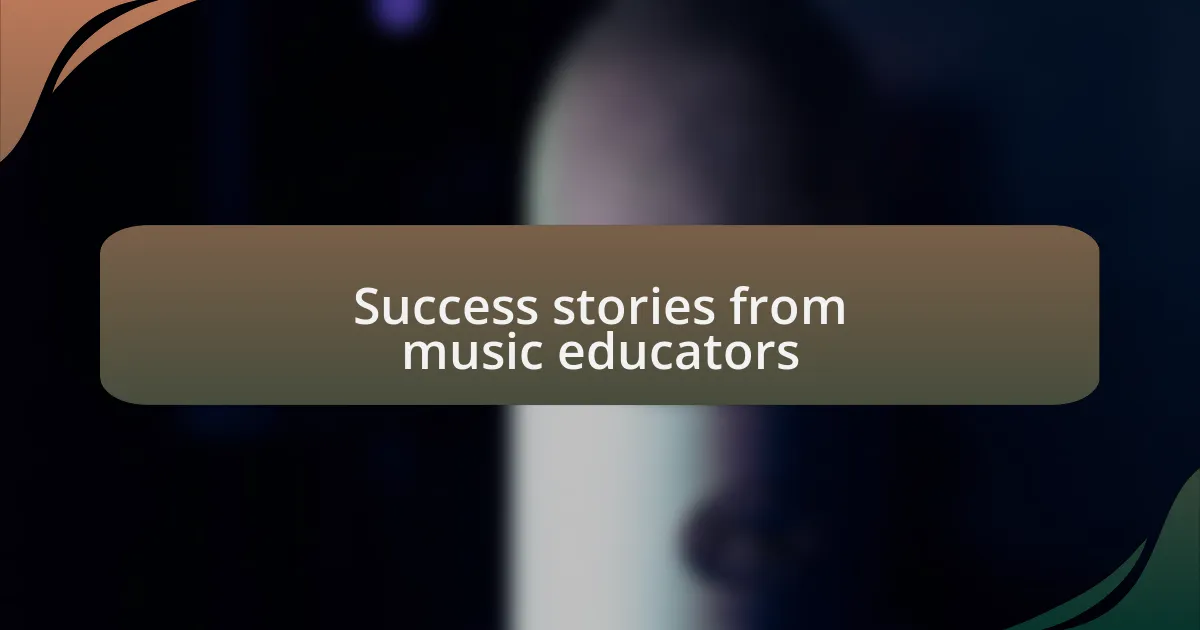
Success stories from music educators
One music educator I know implemented a multisensory approach to teaching music theory and achieved remarkable results. By incorporating visual aids, tactile instruments, and even a few taste tests inspired by musical themes, her students not only grasped complex concepts more easily but also began to express themselves artistically. The joy on their faces as they connected these senses to the music they loved was a true testament to the efficacy of her methods. Isn’t it fascinating how integrating different senses can transform learning into a vibrant experience?
Another success story comes from a colleague who tackled a classroom filled with students who had varying disabilities. She found that using a multisensory approach helped bridge gaps in understanding. For example, through body movement, sound, and colored visual cues, she observed students who typically struggled to engage finally coming alive during lessons. It’s moments like these that make me wonder: how much potential are we unlocking when we embrace the multisensory approach?
Finally, I recall attending a workshop where an educator shared her experience of incorporating nature into music lessons. By taking her students outside to listen to sounds in the environment, they crafted their own compositions inspired by what they heard. I was genuinely moved when she described how her students not only became more attuned to their surroundings but also gained newfound confidence in their creative abilities. What if we broadened our musical horizons by letting nature be part of our learning experience?